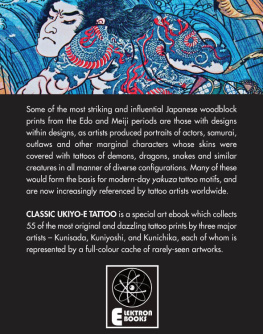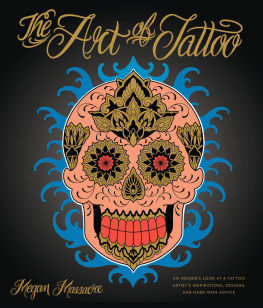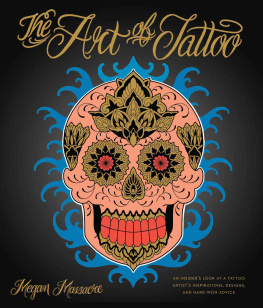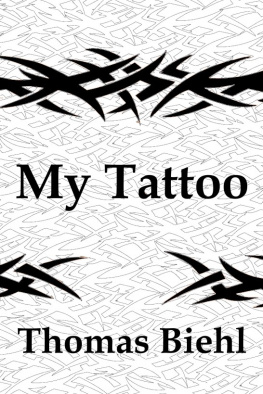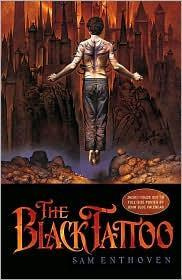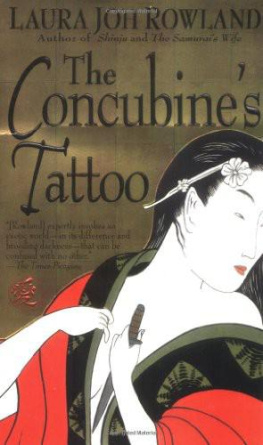Terisa Green - The Tattoo Encyclopedia: A Guide to Choosing Your Tattoo
Here you can read online Terisa Green - The Tattoo Encyclopedia: A Guide to Choosing Your Tattoo full text of the book (entire story) in english for free. Download pdf and epub, get meaning, cover and reviews about this ebook. year: 2003, publisher: Fireside, genre: Art. Description of the work, (preface) as well as reviews are available. Best literature library LitArk.com created for fans of good reading and offers a wide selection of genres:
Romance novel
Science fiction
Adventure
Detective
Science
History
Home and family
Prose
Art
Politics
Computer
Non-fiction
Religion
Business
Children
Humor
Choose a favorite category and find really read worthwhile books. Enjoy immersion in the world of imagination, feel the emotions of the characters or learn something new for yourself, make an fascinating discovery.

- Book:The Tattoo Encyclopedia: A Guide to Choosing Your Tattoo
- Author:
- Publisher:Fireside
- Genre:
- Year:2003
- Rating:5 / 5
- Favourites:Add to favourites
- Your mark:
- 100
- 1
- 2
- 3
- 4
- 5
The Tattoo Encyclopedia: A Guide to Choosing Your Tattoo: summary, description and annotation
We offer to read an annotation, description, summary or preface (depends on what the author of the book "The Tattoo Encyclopedia: A Guide to Choosing Your Tattoo" wrote himself). If you haven't found the necessary information about the book — write in the comments, we will try to find it.
Terisa Green: author's other books
Who wrote The Tattoo Encyclopedia: A Guide to Choosing Your Tattoo? Find out the surname, the name of the author of the book and a list of all author's works by series.
The Tattoo Encyclopedia: A Guide to Choosing Your Tattoo — read online for free the complete book (whole text) full work
Below is the text of the book, divided by pages. System saving the place of the last page read, allows you to conveniently read the book "The Tattoo Encyclopedia: A Guide to Choosing Your Tattoo" online for free, without having to search again every time where you left off. Put a bookmark, and you can go to the page where you finished reading at any time.
Font size:
Interval:
Bookmark:



FIRESIDE
Rockefeller Center
1230 Avenue of the Americas
New York, NY 10020
www.SimonandSchuster.com
Copyright 2003 by Terisa Green
All rights reserved,
including the right of reproduction
in whole or in part in any form.
FIRESIDE and colophon are registered trademarks of Simon & Schuster, Inc.
For information regarding special discounts for bulk purchases, please contact Simon &
Schuster Special Sales at 1-800-456-6798
or business@simonandschuster.com
Designed by Kris Tobiassen
Manufactured in the United States of America
10 9 8 7 6 5 4 3 2 1
Library of Congress Cataloging-in-Publication Data is available.
ISBN 0-7432-2329-2
ISBN-13: 978-0-7432-2329-4
eISBN-13: 978-1-4391-8869-9
Throughout the history and prehistory of the human race, stretching back thousands of years, we have deliberately and permanently marked our skins for myriad purposes: rites of passage; protection from evil; to display group identity, proof of status or wealth; medical therapy; beautification; memorial; and even to guarantee entry into the afterlife, to name only a few. Underlying most of these experiences, though, and providing a common thread among them, is the unspoken understanding that tattoos carry meaning. Sometimes it is general, as in the desire for beauty and appeal, other times specific, as in the display of familial descent. In either case, tattoos are forms of expression.
The thought that tattoo is capable of expressing so many different concepts, and is therefore a means of communication, is not a new one. Writers, observers, tattooists, and the tattooed have all remarked upon this aspect. We seem to intuitively seek something beneath the surface and behind the obvious to explain what we see. The silent exchange that takes place between the bearer and viewer of a tattoo may be one of the most interesting and important aspects of the whole process. Nevertheless, it is an aspect that receives curiously little attention over and above its mention. That light treatment may be due to the fact that much of what we understand when we see a tattoo is communicated through symbolism. By its very nature, symbolism eludes capture in so many words, while the words that we do have to offer are sometimes imprecise. Tattoo symbolism is many times not a direct expression but instead an appeal to the subconscious and intuition. It may call upon ancient forms and graphic representations that, if not ingrained in the human psyche, are at the very least everywhere present and shared across miles and millennia.
When viewed in different countries around the globe, there can be no doubt that the practice of tattooing encompasses enormous variety. Designs, colors, tools, circumstances, and meanings might change from country to country and even from individual to individual. A close inspection of and a thorough delving into the details of the practice reveal a sometimes overwhelming diversity. At the same time, however, there is another way to look at tattoofrom the more distant vantage point made possible by the passage of time and the accumulation of tattoo history and ethnography. When viewed from afar, quite striking similarities and patterns through both time and space become evident, which speak to a common, even fundamental, experience. Certainly not everything in the universe of tattoo warrants deep analysis or is imbued with significance. In fact, we may never understand what it meant, or means, for certain people and their cultures to be tattooed. Even today, some designs are so idiosyncratic or personal that they defy interpretation. In addition, some people simply do not ascribe symbolic content to their tattoo, nor is there any reason why they should.
However, most people and most cultures, for various reasons, do associate tattoos with some deeper meaning. They can be the outward sign of inner transformation, an appeal to the forces of luck, or a declaration of loyalty, love, or sometimes even hatred. They can be whimsical and ironic or reminders of events both grim and uplifting, but as containers of meaning, they are often rich in symbolism, providing a glimpse into our collective and varied past and the range of emotions and experiences that motivate us.
Unfortunately, we dont know where tattooing originated, or when, because the historical and archaeological records of most forms of body art are incomplete. Although skeletal material may be preserved for tens of thousands of years in fossilized form, human skin survives only where intentional or accidental mummification took place. Given the simple technology required and the widespread evidence of tattooing in far-flung places, the practice probably developed independently, many times over, in many different locations, since time immemorial. We know also that, in some parts of the world, it spread amongst peoples who were in close proximity to one another. This section serves to introduce the depth and variety of this enormous subject.
The very earliest evidence of the practice of tattooing is also the most ambiguous. Artifacts recovered from archaeological sites dating from the Upper Paleolithic era (38,000 to 10,000 B.C.E.) in Europe have been interpreted as puncturing tools and pigment reservoirs. The sharp bone needles that might have been used to puncture skin could possibly have served other aims as well, such as general purpose awls. Clay and stone figurines with engraved designs that may represent tattooing have been found in association with these bone tools. It could also conceivably be the case that the bone tools were used in modeling the clay figurines. However, given the artistic elaboration and achievement that is a hallmark of the Paleolithic era (such as the well-known cave paintings of Lascaux) and the ancient roots of tattooing in many parts of the world, it is not unreasonable to speculate that Paleolithic people practiced tattooing.
Tattooed mummies provide the earliest concrete evidence of tattoo, and these have been found in various parts of the world, from Nubia to Peru. A few of the most remarkable of these tattooed people have become famous not only for their tattoos but also for the extraordinary circumstances of their discovery. Probably the most well known of these is a Bronze Age man who has come to be known as Otzi, named for the glacial region in the Alps where he was discovered. Dating to approximately 3300 B.C.E. his skin bore clear evidence of dark blue tattoos in several loca-tions: groups of parallel lines near the lumbar area of the spine as well as the ankles, and a cross on the inside of one knee. The purpose of these marks is unclear but it has been suggested that they may have served as ethnic markers or identifiers and, alternatively, that they may have served as therapy for maladies that left traces on his bones. From the Twenty-first Dynasty of Egypt (2160-1994 B.C.E.) comes a woman named Amunet, a priestess of the goddess Hathor at Thebes, who was tattooed with parallel lines of dots. Some of these tattoos appear on the upper arms but most appear on the abdomen, in curved and elliptical lines below the navela design that has been viewed as sensual.
Perhaps some of the most spectacular tattooed mummies come from the Iron Age of Siberia, from a culture known as the Pazyryk, a group of nomadic horsemen, hunters, and warriors who lived in this steppe region from the sixth to the second centuries B.C.E. In particular, a man who has been characterized as a chief, accompanied by sumptuous grave goods, was elaborately and profusely tattooed with a number of fantastic animals and also realistic ones that included rams, deer, and fish. However, some circular tattoos along his spine are strangely reminiscent of those of Otzi and may have been therapeutic in nature. The similar but separate burial of a young woman of this culture was discovered on the Siberian plateau. She was likewise accompanied by ornate items of great craftsmanship and her arms were tattooed with similar types of designs. The variety in these few early examples hints at the myriad tattoo images found today. The purposes of the tattoos, although unknown, are likely varied and at least some of them are highly charged symbolically. While the earliest tattoos preserved on human skin are abstract designs comprised of combinations of dots and lines, the earliest representational images utilize animals. It is probably no coincidence that animal tattoos are
Next pageFont size:
Interval:
Bookmark:
Similar books «The Tattoo Encyclopedia: A Guide to Choosing Your Tattoo»
Look at similar books to The Tattoo Encyclopedia: A Guide to Choosing Your Tattoo. We have selected literature similar in name and meaning in the hope of providing readers with more options to find new, interesting, not yet read works.
Discussion, reviews of the book The Tattoo Encyclopedia: A Guide to Choosing Your Tattoo and just readers' own opinions. Leave your comments, write what you think about the work, its meaning or the main characters. Specify what exactly you liked and what you didn't like, and why you think so.


